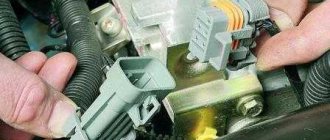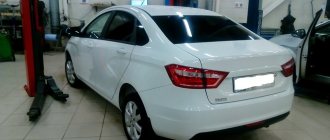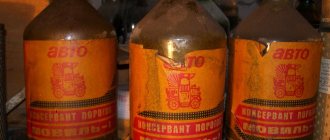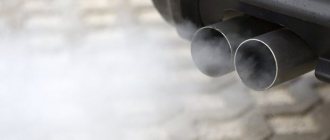Cars admin26.02.2020
How to drain condensate from the gearbox - this question concerns only car owners whose cars have the 1st, 2nd or 3rd generation of gas equipment.
In the 4th generation of gas equipment, there is no drain hole on the gearbox. In injection systems, the reducer pushes out gas under pressure and all liquids along with it. Then it all burns in the cylinders.
The maximum that may be “extra” is resin fractions such as tar. They won't leak anywhere. Something like condensation may accumulate in the gas filter sump. The next time you replace the filter, the “glass” is simply wiped.
Hello! There is a question: is condensate discharged from 4th generation gas equipment? In the 2nd, I know there is, but what about us? and where to look?
Instructions for draining condensate
If you neglect the procedure for draining the condensate, less and less gas will be placed in the cylinder each time, and it will not last as long. In addition, by pouring a normal amount of gas mixture into a cylinder where condensation has already accumulated, you risk filling it to capacity, without leaving the required 15% void for the gas cushion. This is extremely dangerous and can cause the cylinder to rupture or explode at the slightest additional heat or shaking.
To prevent undesirable consequences, let's figure out together how to properly clean condensation from a household gas cylinder.
So, the first thing you need to do is use or release the remaining gas.
When releasing gas, be careful: the pressure can be strong, and the cylinder will cool down significantly. Turn the tube away from you and, preferably, while wearing gloves.
If the tile or other equipment is no longer working well from this cylinder and is chugging, you can simply release the gas on the street. To do this, remove the gearbox and gradually open the valve. Under no circumstances do this near a house, fire, wiring, sparks, or in a confined space: a meadow or field where there are no people and the wind will quickly disperse the gas is ideal.
Violating this simple rule can lead to poisoning, fire or explosion - do not risk your health and those around you. Keep in mind that when a large amount of propane-butane passes from a liquid to a gaseous state, the remaining liquid cools down greatly and the cylinder becomes cold.
When the characteristic hissing sound stops when you open the tap, you can say that the gas has run out. That is, it remains only in a gaseous, and not liquid, state, exactly the same volume as the cylinder, so the pressure is not higher than atmospheric, and it does not come out. Most likely, even at this stage, something will splash around in the cylinder - this is condensation.
The reducer, screwed on after the tap, stabilizes and reduces the pressure of the gas leaving the cylinder to operating pressure. It will not drain the condensate
To get rid of condensation, do this:
- Choose a place remote from housing and fire hazards, preferably an unsown field and not the shore of a reservoir. A wasteland or wild meadow would be ideal. You cannot drain the condensate directly near the gas station where you are going to fill the cylinder.
- If the gearbox is still in place, remove it.
- It is advisable to prepare a glass or metal jar that can be tightly closed along with the drained substance.
- Open the tap and find the pipe underneath where the gearbox was attached.
- Turn the cylinder upside down, with this pipe facing away from you, directing it into the prepared container. For convenience, you can put a hose on it.
- If the liquid does not flow, or not all of it has drained, tilt and shake the container so that the last milliliters flow out.
- Be sure to close the valve so that the cylinder does not fill with air and moisture.
It is advisable that after this procedure nothing splashes in the balloon. Sometimes you can come across a recommendation to fry empty cylinders in the sun with the valves open in order to remove both remaining condensation and water that may have gotten into the cylinder. But this procedure can be unsafe, especially if you forget to open the valve, and an extra few milliliters of condensate will not make a difference, so it is better not to dry the cylinders unnecessarily.
Due to excess pressure, including that caused by heating in the sun, the cylinder can burst, sometimes even explode, this is dangerous
With proper use, there is nowhere for water to come from, so you will not have to figure out how to properly drain water from a household gas cylinder, and drying is not required.
see also
Comments 24
I have a feeling that the gearbox is clogged up, but I don’t want to get into it. A small dip appeared when starting up a hill (as if it was either not enough or flooded) on the flat, rushing to what I need. I’m thinking of pouring WD 40 into the gearbox for a day through the gas inlet hole. Do you think it will help?
Happens to me too.
Similar Reducer, for 6 years and 200+ thousand I haven’t climbed into it. Filter only
At Euro 4, the condensate flies out under pressure.
in fact - for five years you don’t have to look anywhere... after five years I installed a repair kit on the gearbox and that’s the only reason I took it apart and washed everything inside... I haven’t removed the cylinder for 7 years... or cleaned anything...
There is no condensation in the cylinders on cars with LPG. There is also a gas intake tube at the bottom))))) This is not the grandmothers on the street who have a can in an iron box.)))))
It does not merge on the 4th generation.
what kind of condensate? by 4...
Is he not there? I don't know.
If you submitted the cylinder for testing in a timely manner, you wouldn’t have a headache about condensation and dirt
Once every 2 years it is necessary to pressurize the cylinder.
who's going to pressurize it?))))) it's like a piece of paper about the verification of an LPG - give you 300 rubles immediately stamped))))) Now why should I give my uncle 300 rubles for a piece of paper! It’s the same with a balloon - they’ll take money for air and sit contentedly checking the weather on Mars((((
I don’t know about you, but with us the cylinder is handed over, it is tested with air pressure, after which you move it to the installers and they already assemble the system into a heap, check the system for leaks and only then put a seal on the docks. I have observed the entire process many times and am observing it myself, and in the near future I will most likely have to participate.
those. Do you do everything in front of the client? how much money do you take?
I work in this area, testing a 50L cylinder is standard 400-500 RUR, I don’t remember exactly because the testers don’t touch on the financial issue
let's do it again))))) I'm not getting to the bottom of you, BUT! As a rule, no one does anything in front of the client! And verification usually involves visually looking at the cylinder and making a conclusion whether it can be used or not... that’s all, in fact, the whole verification ends there... Another question is in the government structure where cylinders in old houses at grandmothers’ houses stand near the stove... there they change a charged cylinder for an empty cylinder ...there yes...most likely they are checking something...and that...is not a fact...they will drain the condensate and take a visual look and off they go!
the cylinder is inspected for mechanical damage (dents, dents, welds) is installed in the installation and 36 kg of air is pressed into it, before this it is washed with hot water, if after the pressure test it does not burst, no dents appear, then the cylinder is stamped with the next test date and a stamp with a record in documents. Household cylinders are inspected for physical damage, if the test date has arrived, then the valve/valve is dismantled, washed with hot water into the installation for pressure testing, again inspected, the valve/valve is installed back (at the client’s request, the valve can be replaced with valves or vice versa), filled with gas and checked for leaks , if there is a leak (along the cone/membrane/the valve itself does not pressurize), the gas is drained and twisted, or the valve/valve is repaired, the date of the next test and a stamp are put on the passport.
this is all wonderful! If the client wants, will you do this procedure in front of him?
The territory of the station is a dangerous object; unfortunately, strangers are not allowed there. I foresee the next comment in the style of saying that you are not doing anything there...
absolutely right))))) if the balloon is not visually rotten and neither oblique nor crooked, then nothing is done... not because there is no equipment, but simply laziness... I’m not saying that you are bad or someone else is bad... everyone wants to eat! so everyone has to decide for themselves! There are just people who feel calmer with verification with a seal, and someone is squeezing money))))) that’s all)))))
The territory of the station is a dangerous object; unfortunately, strangers are not allowed there. I foresee the next comment in the style of saying that you are not doing anything there...
yes))))) and I may be wrong too! and I don’t trust words either, not because of a good life... so ignorance gives rise to guesswork... you can make a video recording... i.e. a person watches the verification process in real time and is not on the premises...
the bosses will hang themselves on video recording, but in general I don’t argue that if you want to test it, they’ll test it for you, if you stupidly need a stamp, then everything can be solved without any problems either, I didn’t say in any of my messages that everything here is so honest that a leftist doesn’t will pass
Does each refill of your gas cylinder last for a shorter period of time? Or maybe you noticed a deterioration in the quality of the flame - the burner puffs and goes out from time to time? The reason for this may be condensation that has accumulated in the cylinder after many refills. If you drain it and pump in high-quality gas at a specialized gas station, gas appliances from the cylinder will begin to work no worse than from the central gas pipeline: stably, smoothly and without soot.
In this article we will figure out what gas condensate is, where it comes from in the cylinder, whether it is necessary to get rid of it, and, most importantly, how to drain the condensate from a household gas cylinder yourself.
Terms of service
Normal and stable operation of gas equipment on a car is possible only with its timely maintenance (maintenance). Manufacturers of 1st, 2nd and 3rd generation gas equipments claim to carry out routine maintenance within 10-15 thousand km. car mileage. Which includes operations such as:
But in reality, it is often necessary to reduce the service interval based on mileage, for several reasons:
Safety rules when handling the cylinder
Gas cylinders are extremely dangerous. Every year, dozens and hundreds of household gas cylinders explode, destroying homes and killing people, and in most cases the reason for this is a violation of the rules of their operation.
When filling up gas legally, at a specialized substation, along with a full cylinder, you will receive a reminder on its safe transportation, storage and use. Among other things, it is prohibited to install cylinders closer than half a meter from a gas stove or a meter from a stove, heater or radiator.
It is best to place them in a special metal cabinet with ventilation or under a canopy on the street, near the north wall and away from window and doorways
You should not allow the cylinders to heat up - from any devices or in the sun - this can lead to their rupture. Also, they should not be stored in a tightly closed cabinet without ventilation at the bottom of the doors: in the event of a leak, the gas will fill the cabinet, and when combined with oxygen from the air, the mixture becomes extremely explosive. The slightest spark or electrical discharge is enough and there will be an explosion.
We also recommend that you read the article: Why gas cylinders explode: the main causes of accidents.
You should not use a winter gas mixture with a high propane content in the summer: it will evaporate too actively, and the cylinder may swell or even burst from excess pressure - and this is with 3 mm thick steel walls.
It is also prohibited to use swollen, dented or damaged cylinders: there is no guarantee that it is sealed and will withstand gas pressure reaching 8 bar.
Safety rules when handling the cylinder
Gas cylinders are extremely dangerous. Every year, dozens and hundreds of household gas cylinders explode, destroying homes and killing people, and in most cases the reason for this is a violation of the rules of their operation.
When filling up gas legally, at a specialized substation, along with a full cylinder, you will receive a reminder on its safe transportation, storage and use. Among other things, it is prohibited to install cylinders closer than half a meter from a gas stove or a meter from a stove, heater or radiator.
You should not allow the cylinders to heat up - from any devices or in the sun - this can lead to their rupture. Also, they should not be stored in a tightly closed cabinet without ventilation at the bottom of the doors: in the event of a leak, the gas will fill the cabinet, and when combined with oxygen from the air, the mixture becomes extremely explosive. The slightest spark or electrical discharge is enough and there will be an explosion.
You should not use a winter gas mixture with a high propane content in the summer: it will evaporate too actively, and the cylinder may swell or even burst from excess pressure - and this is with 3 mm thick steel walls.
It is also prohibited to use swollen, dented or damaged cylinders: there is no guarantee that it is sealed and will withstand gas pressure reaching 8 bar.
Maintenance of HBO-2 generations in 15 minutes. — Daewoo Sens, 1.3 l., 2003 on DRIVE2
It's time to service HBO-2.
What should be done:
1. Replace the coarse filter. 2. Drain the condensate from the gearbox.
What you will need for this:
1. 5mm hexagon. 2. 6mm hexagon. 3. New coarse filter. 4. New filter o-rings.
How to do it if you have the popular Tomasetto AT-07 gearbox:
1. tighten the shut-off valve of the flow line on the multivalve. There is only one valve on my multivalve.
2. start the engine and let it run on gas until it stalls. If it stalls, the gas supply from the line is exhausted and the pressure drops.
3. Using a 5mm hexagon, unscrew the three bolts securing the filter cover and remove the cover.
4. Take out the large rubber ring. We see an accumulation of graphite chips. There are two ways to remove it so that graphite does not get into the gearbox.
a) slightly open the flow line valve on the multivalve for a couple of seconds, before removing the filter from the seat. At the same time, you need to make sure that no one smokes or lights fires near the hood. It is unlikely to flare up, but God protects those who are careful.
b) if you have a vacuum cleaner, do it with a vacuum cleaner (that’s what I did)
5. Reassemble in reverse order. We place the small ring, the filter, and the large ring in the groove, and carefully, evenly, but tightly tighten the filter cover with three bolts. Twisting them one by one.
Condensate drain:
1. Lay a rag or place a container under the gearbox. 2. Unscrew the bolt at the very bottom of the gearbox, which is in the same plane as the coolant and gas supply fittings. 3. We wait until it merges. 4. Screw the bolt back in.
Let's check that we haven't forgotten anything. Let's see if we collected everything securely. Smoothly open the valve on the multivalve (if sharply, the high-speed valve may work and emergency shut off the flow) - VOILA, everything is ready.
Let's start the engine and enjoy.
With cover removed
With filter removed.
New and old.
Clogged filter.
I changed my filter 10 thousand ago. The condensate was drained into the first. Less than one cube came out.
www.drive2.ru
Conclusions and useful video on the topic
To make sure there are no questions left, we suggest watching a video about how condensate is drained from an empty cylinder:
When using gas cylinders at home, do not forget about the need for their maintenance, because this is a matter of your safety. Draining the condensate and checking the integrity yourself or entrusting it to professionals is up to you, and we told you how to do it effectively and safely.
Do you use gas cylinders and still have condensation after using the gas? Tell us how you get rid of it - the feedback form is located below.
If you have any questions or want to express your opinion about the advisability of draining condensate at home, please join the discussion on the topic.










